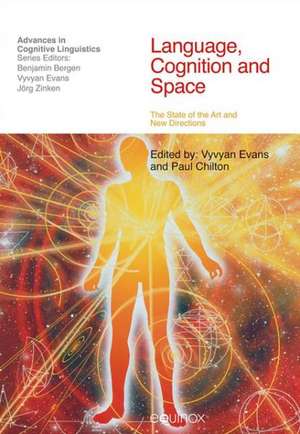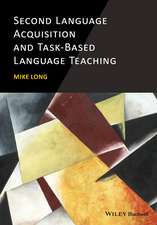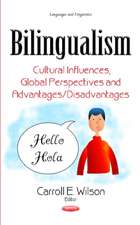Language, Cognition and Space: Advances in Cognitive Linguistics
en Limba Engleză Paperback – 17 iun 2010
Preț: 518.49 lei
Nou
Puncte Express: 778
Preț estimativ în valută:
99.22€ • 107.74$ • 83.35£
99.22€ • 107.74$ • 83.35£
Carte tipărită la comandă
Livrare economică 22 aprilie-06 mai
Preluare comenzi: 021 569.72.76
Specificații
ISBN-13: 9781845535018
ISBN-10: 1845535014
Pagini: 519
Ilustrații: 156 figures
Dimensiuni: 168 x 241 x 30 mm
Greutate: 0.86 kg
Editura: Equinox Publishing (Indonesia)
Seria Advances in Cognitive Linguistics
ISBN-10: 1845535014
Pagini: 519
Ilustrații: 156 figures
Dimensiuni: 168 x 241 x 30 mm
Greutate: 0.86 kg
Editura: Equinox Publishing (Indonesia)
Seria Advances in Cognitive Linguistics
Notă biografică
Vyvyan Evans is Professor of Linguistics at Bangor University. He has written and edited a number of books on cognitive linguistics including: The Semantics of English Prepositions (with Andrea Tyler), The Structure of Time, Cognitive Linguistics (with Melanie Green), and The Cognitive Linguistics Reader (co-edited with Ben Bergen and Joerg Zinken), published by Equinox. Paul Chilton is Professor of Linguistics at the University of East Anglia. He has published widely in the areas of cognitive linguistics and discourse studies including the following books: Security Metaphors: Cold War Discourse from Containment to Common European Home, Analysing Political Discourse: Theory and Practice, and Space, Time and Distance: the Geometry of Discourse.
Cuprins
Introduction I PERCEPTION AND SPACE 1. The perceptual basis of spatial representation. Vyvyan Evans II THE INTERACTION BETWEEN LANGUAGE AND SPATIAL COGNITION 2. Language and space: Momentary interactions. Barbara Landau (John Hopkins University), Banchiamlack Dessalegn (Johns Hopkins University), and Ariel Micah Goldberg (Johns Hopkins Univeristy) 3. Language and inner space. Benjamin Bergen (University of Hawai'i, Manoa), Carl Polley (University of Hawai'i, Manoa), and Kathryn Wheeler (University of Hawai'i, Manoa) III TYPOLOGICAL, PSYCHOLINGUISTIC AND NEUROLINGUISTIC APPROAHCES TO SPATIAL REPRESENTATION 4. Inside in and on: Typological and psycholinguistic perspectives Michele Feist (University of Louisiana at Lafayette) 5. Parsing space around objects. Laura Carlson (University of Notre Dame) 6. A neuroscientific perspective on the linguistic encoding of categorical spatial relations. David Kemmerer (Purdue University) IV THEORETICAL APPROACHES TO SPATIAL REPRESENTATION IN LANGUAGE 7. The genesis of spatial terms. Claude Vandeloise (Louisiana State University) 8. Forceful prepositions. Joost Zwarts (Utrecht University) 9. From the spatial to the non-spatial: The 'state' lexical concepts of in, on and at. Vyvyan Evans V SPATIAL REPRESENTATION IN SPECIFIC LANGUAGES 10. Static topological relations in Basque. Iraide Ibarretxe-Antunano (Universidad de Zaragoza) 11. Taking the Principled Polysemy Model of Spatial Particles Beyond English: The Case of Russian za. Darya Shakhova (Georgetown University) and Andrea Tyler (Georgetown University) 12. Frames of reference, effects of motion, and lexical meanings of Japanese FRONT/BACK terms. Kazuko Shinohara (University of Agriculture and Technology, Tokyo) and Yoshihiro Matsunaka (Tokyo Polytechnic University) VI SPACE IN GESTURE AND SIGN-LANGUAGE 13. How spoken language and signed language structure space differently. Leonard Talmy (State University of New York, Buffalo) 14. Geometric and image-schematic patterns in gesture space. Irene Mittelberg (Vrije Universiteit Amsterdam) VII MOTION 15. Translocation, language and the categorization of experience. Jordan Zlatev (Lund University), Johan Blomberg (Lund University), and Caroline David (Universite de Montpellier 3) 16. Motion: A conceptual typology. Stephanie Pourcel (Bangor University) VIII THE RELATION BETWEEN SPACE, TIME AND MODALITY 17. Space for thinking. Daniel Casasanto (MPI for Psycholinguistics, Nijmegen) 18. Temporal frames of reference. Jorg Zinken (Portsmouth University) 19. From mind to grammar: Coordinate systems, prepositions, constructions. Paul Chilton




















